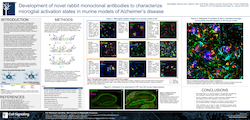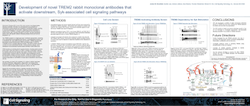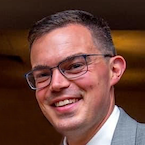The amyloid cascade hypothesis1, a theory initially proposed over 30 years ago, continues to be the linchpin in Alzheimer’s disease (AD) diagnosis and therapeutic research. The hypothesis suggests that the processing of amyloid precursor protein (APP), which occurs sequentially by β-secretase (BACE) and γ-secretase (a complex of presenilin 1, presenilin 2, nicastrin, APH-1, and PEN2), leads to amyloid-beta (Aβ) peptide production, accumulation, and aggregation into Aβ plaques. The hypothesis further suggests that the formation of these plaques leads to microglial activation, neuroinflammation, tau hyperphosphorylation, tau tangle formation, and neurodegeneration.
Although the hypothesis has had its detractors over the years, recent developments and therapeutic breakthroughs—such as the antibody drug candidates lecanemab and donanemab—have provided support for this classic theory.
Promising Antibody Drug Candidates for Alzheimer's Disease
Late last year, Biogen and Eisai released promising Phase 3 data on their antibody drug candidate lecanemab, which acts to bind and promote the clearance of Aβ plaques. Critically, the data suggests that the clearing of these plaques led to a slower rate of cognitive decline in AD patients. The promising results of this study ultimately led to FDA approval of lecanemab in January 2023.
Earlier this month, Eli Lilly also released positive top-line results from the Phase 3 study of their antibody drug candidate donanemab, which also promotes the clearance of Aβ plaques and is suggested to slow cognitive decline in AD patients. FDA approval of donanemab is expected to be finalized later this year. It is important to note that these two therapeutics, though promising, do not come without some caution. Nonetheless, these antibody drugs are promising developments for patients that suffer from a disease that is growing exponentially in the population.
Blog: SfN 2022: Ups and Downs in Neurodegenerative Research—New Tools, Models, and Technologies
However, a major challenge for lecanemab, donanemab, and other future therapeutics is that their benefits are heavily linked to the stage of the patient’s disease. These drugs may slow progression, but they cannot reverse it. Therefore, the earlier physicians are able to diagnose and treat AD, the greater the impact will be. The development of better diagnostic tools, and in turn, treatment plans, requires a better understanding of the cellular and molecular mechanisms underlying AD. It also requires the identification of more specific and robust biomarkers related to these mechanisms.
New Alzheimer's Therapeutics, Diagnostics & Mechanisms at AD/PD 2023
The field of neuroscience and neurodegenerative research continues to have a heavy focus on early disease identification and novel treatments. This was highlighted at this year’s annual AD/PD 2023 Alzheimer's & Parkinson's Diseases Conference, where over 4,000 attendees gathered in Gothenburg, Sweden. Central to this five-day meeting were discussions about therapeutic developments, diagnostic tools, and mechanisms of neurodegeneration.
Therapeutic Development: Biogen’s ASO Release
During one well-attended session at AD/PD, Biogen announced initial Phase 1 study results for BIIB080, a tau antisense oligonucleotide (ASO), the full results of which were published in April. This therapeutic, which acts to reduce total levels of the protein, was given to patients with mild AD. The results suggest that the ASO was able to reduce soluble tau by 60% (as measured in CSF), and further reduced tau tangle burden in the brain.
The study was very well received at the meeting, garnering a great deal of excitement from those in attendance. It is important to note that while the study was small, and there remain several hurdles to clear before FDA approval can be pursued, it suggests that intervening at later stages of the amyloid cascade may be a fruitful endeavor for therapeutic advancement.
Interactive Alzheimer's Disease Signaling Pathway: Molecular and Cellular Biology of Alzheimer’s Disease
The correlation of soluble tau levels in CSF to tau tangle burden in the brain provides further evidence of the need for better diagnostic tools to identify those in the earliest stages of neurodegeneration.
Diagnostic Tools: Fluid-Based Biomarkers
The ASO results, and many other talks given at the AD/PD 2023 meeting, emphasized the need for robust fluid biomarkers that enable the detection and monitoring of neurodegeneration. Researchers highlighted the use of specific tau phosphorylation sites, including phospho-tau Thr217, Thr181, and Thr231, as well as other markers such as Aβ 40/Aβ 42 ratio, NfL, and GFAP. Among the researchers was Kaj Blennow from the University of Gothenburg, who discussed the importance of using CSF and blood biomarkers in ELISA platforms during his plenary talk.
%20ELISA%20Kit%20%2320882_AD.png?width=520&height=260&name=FastScan%20%CE%B2-Amyloid%20(1-40)%20ELISA%20Kit%20%2320882_AD.png)
The FastScan™ β-Amyloid (1-40) ELISA Kit #20882 detects human Aβ-40, but not Aβ-43, Aβ-42, Aβ-39, Aβ-38, and Aβ-37 peptides. The absorbance at 450 nm using #20882 for a panel of human β-amyloid peptides is shown in the upper figure. The corresponding western blots using β-Amyloid (1-40) antibody (top panel) and β-Amyloid antibody (bottom panel) are shown in the lower figure.
CSF levels of these proteins have been shown to correlate with neuronal injury and neurodegeneration. Using CSF to detect protein levels has its advantages, chief among them being that proteins found within CSF are derived solely from the central nervous system (CNS). On the other hand, obtaining CSF from patients is an invasive and costly process that may be difficult to scale at the population level. Therefore, the goal of many researchers is to move toward blood-based biomarkers. Although there are added challenges to using blood, namely that many of the markers currently being investigated are also expressed outside of the brain, obtaining and analyzing blood samples is less invasive, less costly, and potentially more scalable in the long run.
A current challenge that exists in any fluid biomarker approach is the lack of ability to discriminate between diseases. In an ideal state, a panel could be performed with unmodified proteins and proteins that have undergone specific post-translational modifications (PTMs) associated with a particular neurodegenerative disease. Being able to identify not only that a disease is in its early stages, but also which disease it is, will be key to any personalized neurological medicine treatment course in the future.
In order to achieve this long-term goal, biomarker specificity for AD, mild cognitive impairment (MCI), Parkinson’s disease (PD), progressive supranuclear palsy (PSP), frontotemporal dementia (FTD), amyotrophic lateral sclerosis (ALS), and other neurodegenerative diseases needs to be established. Once biomarkers are identified, the development of better tools, including highly sensitive and specific antibody-based assays for the detection of these proteins, will be key. The path to these developments begins with gaining a better understanding of the cellular and molecular mechanisms of each neurodegenerative disease.
Mechanisms of Neurodegeneration: Neuroinflammation, Microglia, and TREM2
Neuroinflammation, a hallmark of neurodegeneration and a key aspect of the amyloid cascade, remains a focus in cellular and molecular neurodegenerative research.
Neuroinflammation occurs when glial cells, like microglia and astrocytes, become reactive under diseased or damaged conditions. These activation states, and the signaling cascades that precede them, are under intense scrutiny in the field. There were several sessions at the ADPD meeting that highlighted the importance of investigating neuroinflammation in the context of microglia activation states. The role triggering receptor expressed on myeloid cells 2 (TREM2) plays in these events was of particular interest.
Video: Visualizing Microglia in Whole-Tissue Cleared Mouse Brain
Christian Haas presented data on the Denali 4D9 antibody clone that is currently in phase 1 clinical trials for upregulating TREM2-dependent microglial activation in order to promote Aβ clearance. In the same vein, Vigil Neuroscience discussed positive developments regarding their TREM2 small molecule ligand agonist.
Despite progress in this field, there remains much unknown about the downstream targets and signaling cascades related to TREM2-dependent and TREM2-independent microglial activation. Antibody tools capable of distinguishing microglial activation states and providing further clarity into the role particular proteins play in driving them are key to understanding the mechanisms related to neuroinflammation and neurodegeneration.
Cell Signaling Technology at AD/PD 2023
We were inspired by the groundbreaking work that was presented at AD/PD 2023, and returned to the lab with renewed invigoration for developing antibody tools to enable the next generation of AD diagnostics and treatments.

Me (Jordan Hirschfeld, Associate Scientist) and Richard Cho, PhD, CST Associate Director of Neuroscience, presenting our poster on detecting and characterizing microglia activation states at AD/PD 2023.
At the show, CST presented two posters about relevant antibody tools for AD, one that called attention to the importance of detecting and characterizing microglia activation states, and another highlighting how researchers may be able to investigate TREM2 signaling cascades downstream of activation:
 |
|
 |
The field of neuroscience is closer than ever to innovative and impactful solutions for neurodegenerative disease intervention, as was supported by the presenters and attendees at AD/PD 2023.
I look forward to more developments in the coming year, and to seeing what is discussed at next year’s meeting!
Select References
-
Hardy JA, Higgins GA. Alzheimer's disease: the amyloid cascade hypothesis. Science. 1992;256(5054):184-185. doi:10.1126/science.1566067
23-EMG-41000




/42157_chimeric%20antibody%20blog%20featured3.webp)

